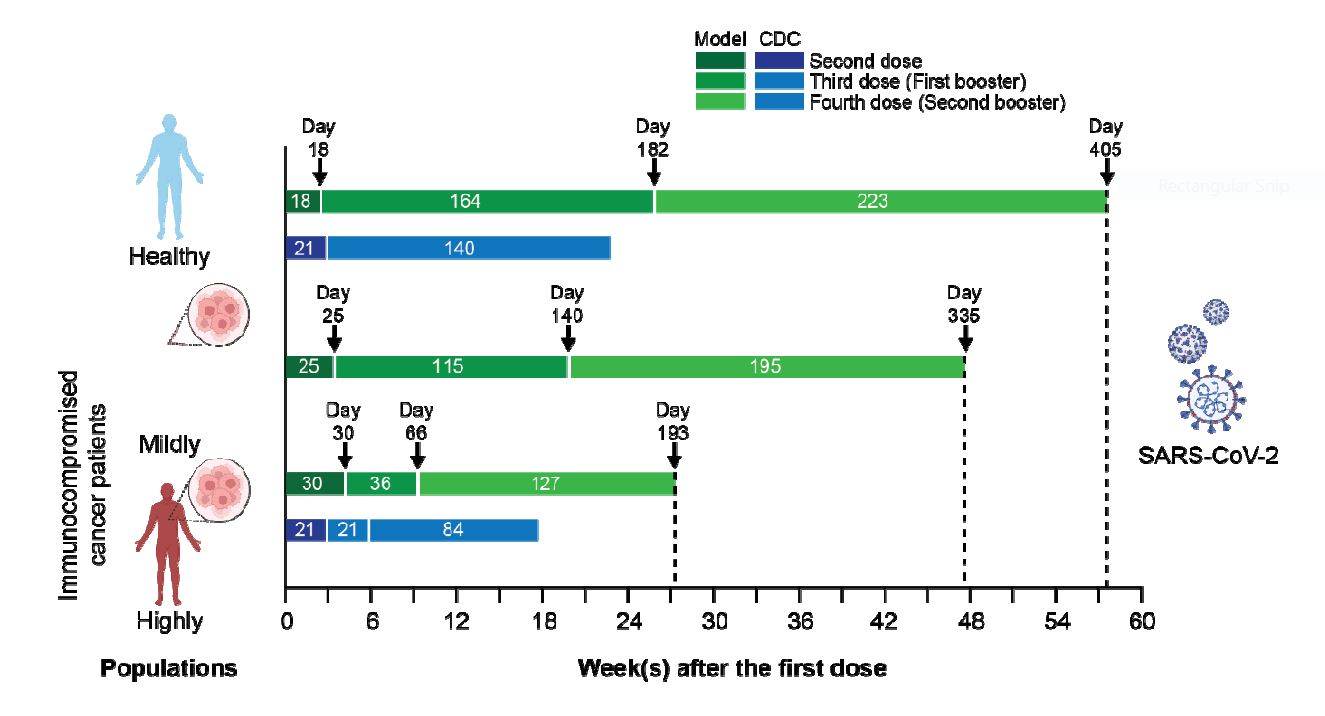“Forecasting immune response allows us to identify dosing strategies that may improve vaccine effectiveness and ensure long-term protection against the virus, based on the needs of individual subpopulations,” said the study’s corresponding author, Prashant Dogra, Ph.D. “For example, immunocompromised patients may exhibit reduced antibody production after vaccination than what is seen in the general population.”
The researchers created a computational tool that can reliably simulate the immune response in thousands of demographically diverse patients in a matter of minutes, allowing them to answer questions that otherwise would be expensive and time-consuming experimentally or clinically. The tool helped them identify the best dosing protocols to ensure protection for prolonged periods. One interesting result in patients with a high degree of immunosuppression was that a slight delay in the second dose allows the immune system to recover and produce more antibodies and, therefore, provides greater protection.
Dogra, an assistant research professor of mathematics in medicine, led the project together with Zhihui “Bill” Wang, Ph.D., research professor of computational biology in medicine, and Vittorio Cristini, Ph.D., the director of the Mathematics in Medicine Program at the Houston Methodist Academic Institute. The study, titled “A modeling-based approach to optimize COVID-19 vaccine dosing schedules for improved protection,” is under peer review with a prominent medical journal and currently posted on the preprint server medRxiv.
During a public health emergency, such as the COVID-19 pandemic, time and resource limitations create a challenge to efficiently conduct clinical trials to assess the safety and effectiveness of new vaccines. This can lead to inequitable inclusion of subjects from various age groups, genders, racial and ethnic minorities, among other demographic variables.
So, while the CDC guidelines only distinguish between healthy and immunocompromised subjects, the math model expands upon that and identified striking differences in vaccine efficacy across a spectrum of subjects with varying levels of immune-health competency. It revealed the level of variation in immune response across the subjects of these subpopulations and the protection offered by vaccines against the original versus mutant strains of SARS-CoV-2.
Identifying critical waiting windows for highly immunocompromised subjects, such as cancer patients undergoing chemotherapy, allows the immune system to recover to the point that it can produce enough vaccine-induced antibodies for effective disease protection. Their model has the potential to supplement phase 3 vaccine clinical trials by extensively exploring the effects of population-scale biological variability on vaccine outcomes in a virtual population, which is otherwise hard to capture in a real clinical trial.
“We developed the mathematical model based on literature-derived clinical trial data for mRNA-based COVID-19 vaccines and used the model to perform computational experiments to explore various clinical scenarios and identify strategies for improved vaccine outcomes,” Wang said. “We performed thousands of simulations to represent a diverse virtual population of human subjects who received a simulated vaccination and analyzed the results to identify the optimal vaccination schedules for various patient categories.”
While the paper covers immunocompromised subpopulations, the research team also currently is studying various other special populations, such as racial and ethnic groups, the elderly, pregnant women and pediatrics.
Moving forward, they will be making their model generalizable to different vaccines and infections that will allow them to create a reliable tool that can be applied to future outbreaks to support the development of new vaccines and guide public health policy in this context. Over the next year, they plan to publish an updated version of the model that can be applied to and has been validated on multiple vaccines.
Dogra, Wang and Cristini’s collaborators on this study were their Houston Methodist Research Institute colleagues Jin Wang and H. Dirk Sostman; Carmine Schiavone and Sergio Caserta from the University of Naples Federico II in Italy; Javier Ruiz-Ramírez from Universidad Autónoma de Aguascalientes in Mexico; and Daniela I. Staquicini, Christopher Markosian, Renata Pasqualini and Wadih Arap with Rutgers Cancer Institute of New Jersey.
The study was supported, in part, by the Cockrell Foundation, the National Institutes of Health (Grants 1R01CA253865, 1R01CA222007, 1R01CA226537), Rutgers Cancer Institute of New Jersey (NCI Cancer Center Support Grant P30CA072720) and by awards from the Levy-Longenbaugh Donor-Advised Fund.
For more information about Houston Methodist, visit houstonmethodist.org. Follow us on Twitter, Facebook, LinkedIn, and our On Health and Leading Medicine blogs.
———————–
For more information: A modeling-based approach to optimize COVID-19 vaccine dosing schedules for improved protection. medRxiv. (in press Jan. 31, 2023) Prashant Dogra, Carmine Schiavone, Zhihui Wang, Javier Ruiz-Ramírez, Sergio Caserta, Daniela I. Staquicini, Christopher Markosian, Jin Wang, H. Dirk Sostman, Renata Pasqualini, Wadih Arap and Vittorio Cristini. DOI: https://doi.org/10.1101/2022.09.14.22279959
###


